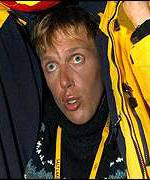- Sep 25, 2009
- 7,527
- 1
- 0
i agree with both of you trond and tomas - a proper diagonal striding technique is more technically challenging than the proper skating. i reckon, this is because the timing of a propulsive force in striding is much shorter (and therefore is more critical) than when skating. i also consider classic style a poetry in motion compared to skating but that‘s altogether a different matter…
i think cloxxki was referring to a tendency of many tall skiers (i and cloxxki are about the size of daniel richardsson) to naturally excel at double-poling. i am not sure of the exact bio-mechanics behind, but perhaps being more secure and stable due to lack of diagonal side-to-side rocking, allows our longer limbs work as an efficient system of levers generating a longer propulsion cycle.
trond, i enjoy reading the way you write about xc skiing. but I am a numbers guy and have been playing myself with ski prepping for years. i don’t find your subjective descriptions of ski prepping differences a reliable yardstick when compared to blood doping effects.
in an earlier post i attempt to find a scientifically sound % improvement due to better prepping. at best, one can find numbers around 3%, whereas blood doping (though i’d argue tubless’ 7% is pushing the limit at elite level) 3-5% is common due to blood doping.
an interesting point in case is a recent study by Øyvind Sandbakk. he found that the difference between the world and national class was 7%. this imo validates a point that a good skier with enough epo can become a world class.
i think cloxxki was referring to a tendency of many tall skiers (i and cloxxki are about the size of daniel richardsson) to naturally excel at double-poling. i am not sure of the exact bio-mechanics behind, but perhaps being more secure and stable due to lack of diagonal side-to-side rocking, allows our longer limbs work as an efficient system of levers generating a longer propulsion cycle.
trond, i enjoy reading the way you write about xc skiing. but I am a numbers guy and have been playing myself with ski prepping for years. i don’t find your subjective descriptions of ski prepping differences a reliable yardstick when compared to blood doping effects.
in an earlier post i attempt to find a scientifically sound % improvement due to better prepping. at best, one can find numbers around 3%, whereas blood doping (though i’d argue tubless’ 7% is pushing the limit at elite level) 3-5% is common due to blood doping.
an interesting point in case is a recent study by Øyvind Sandbakk. he found that the difference between the world and national class was 7%. this imo validates a point that a good skier with enough epo can become a world class.






